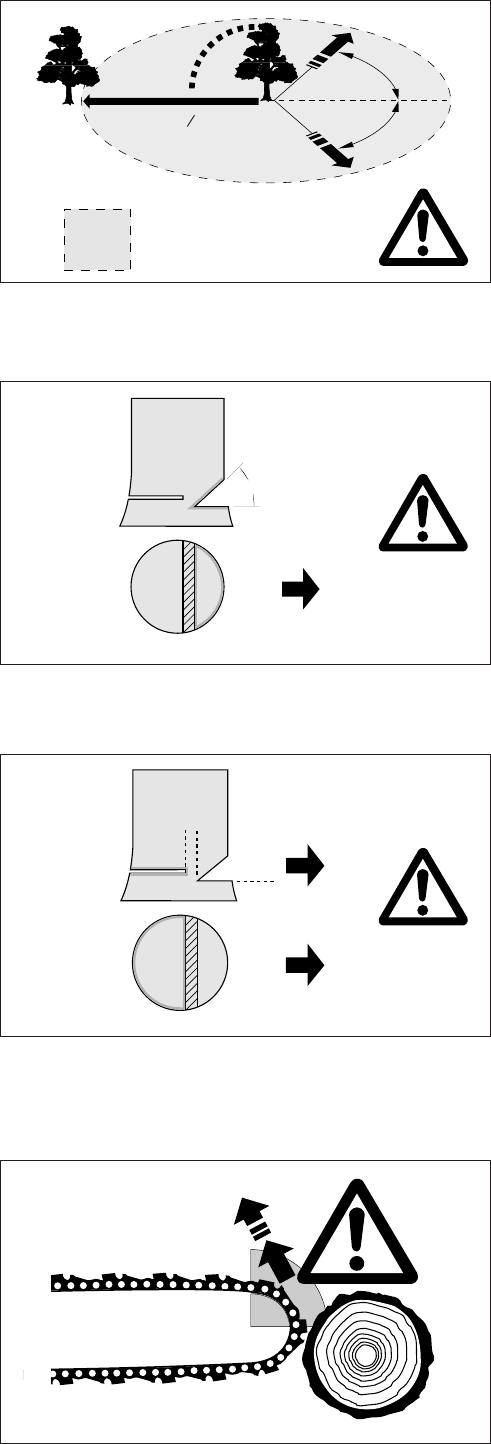
7
45°
45°
2
1
16
17
18
19
2
B
B
C
C
D
A
A
45
o
CAUTION:
Do not fell or debranch trees unless you are specially
trained for it! There is a high risk of injury! Make sure to
follow local regulations.
- Before cutting down a tree ensure that
a) only those persons are within the working range which are
actually involved in cutting down the tree
b) b) all persons involved in the felling have an unhindered
retreat route (the retreat path should be about 45° diago-
nally and to the rear away from the direction of fall). Be
aware of the increased risk of stumbling from electric
cables!
c) the bottom part of the trunk is free from foreign bodies,
underbrush and branches. Make sure to have a safe footing
(risk of stumbling).
d) the next working place is at least 2 1/2 tree lengths away
(16). Before cutting down the tree check the direction of fall
and make sure that there are neither other persons nor any
objects within a distance of 2 1/2 tree lengths (16).
- Judging the tree:
Direction of hanging - loose or dry branches - height of the tree
- natural hang over - is the tree rotten?
- Take into account the direction and the velocity of the wind. If
strong gusts are occuring, do not perform any cutting down
works.
- Cutting the roots:
Start with the strongest root. First perform the vertical and then
the horizontal cut.
- Notching the trunk (A, 17):
The notch determines the direction of fall and guides the tree.
The trunk is notched perpendicular to the direction of fall and
penetrates 1/3 -1/5 of the trunk diameter. Perform the cut near
the ground.
- When correcting the cut always do so over the whole width of
the notch.
- Cut down the tree (B, 18) above the bottom edge of the notch
(D). The cut must be exactly horizontal. The distance between
both cuts must be approx. 1/10 of the trunk diameter.
- The material between both cuts (C) serves as a hinge. Never
cut it through, otherwise the tree will fall without any control.
Insert felling wedges in the cut (B, 18) in good time.
- Secure the cut only with wedges made of plastic or aluminium.
Do not use iron wedges.
- When cutting down a tree always stay sideways of the falling
tree.
- When withdrawing after having performed the cut down be
aware of falling branches.
- When working on a sloping ground the user of the electric chain
saw must stay above or sidewards of the trunk to be cut or the
already cut down tree.
- Be aware of trunks which may roll towards you.
Kickback
- When working with the electric chain saw dangerous kickbacks
may occur.
- Kickback occurs when the tip of the blade(especially the top
quarter) inadvertently comes into contact with wood or other
solid objects.
- In this case the electric chain saw is thrown without any control
and with high energy potentials in the direction of the user (risk
of injuries).
In order to prevent kickbacks follow the indicated
instructions:
- Never apply the end of the bar when starting to make a cut.
Always observe the end of the bar.
- Never use the bar end for sawing. Be careful when continuing
to cut.
- When starting to perform a cut the chain must be running.
- Ensure that the chain is always sharpened correctly. Pay
special attention to the hight of the depth limiter (for detailed
information see the chap. "Sharpening the saw chain").
- Never cut several branches at the same time. When cutting a
branch ensure that no other branch is touched.
- When crosscutting a trunk be aware of the trunks next to it. It
is recommended to use a saw jack.
= cutting down range


















